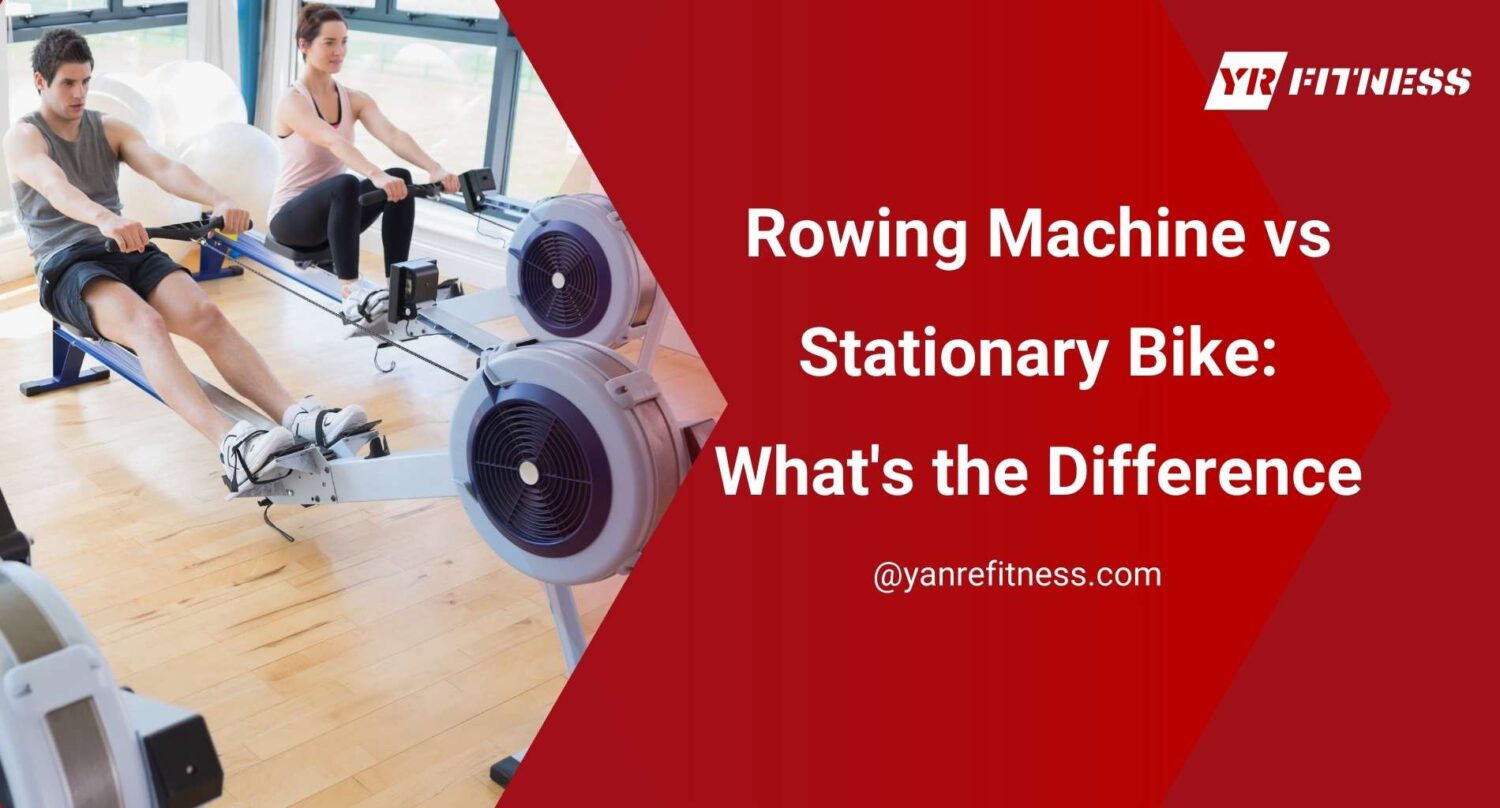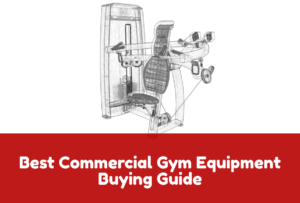A client called me in a panic.
His gym had invested in five treadmills. But half his members were older adults. Joint pain was common. The machines weren’t being used.
“I should’ve asked you first,” he said.
That stuck with me.
Choosing between a stepper and a treadmill isn’t just about cardio. It’s about who you’re serving, what they need, and what your space can handle.
In this guide, I’ll share what I’ve learned from years in the industry so you don’t make a costly mistake.
We’ll break it down by:
- Performance
- Space and layout
- Maintenance needs
- Member experience
By the end, you’ll have a clear answer and a plan that fits your gym.
So let’s get started!
- 1. Which Machine Appeals More to Gym Members?
- 2. Space and Layout Considerations for Your Gym or Showroom
- 3. Maintenance, Durability, and Commercial Longevity
- 4. Cost Comparison: Upfront Investment and Long-Term Value
- 5. Member Engagement and Retention Impact
- 6. Market Demand Insights for Distributors
- 7. Safety, Injury Risks, and User Guidance
- 8. Final Decision: Which Machine Is Better for Your Business?
- Conclusion
1. Which Machine Appeals More to Gym Members?
A few months ago, I walked into one of my client’s gyms during peak hours. The bikes were full. Every single one. Meanwhile, two rowing machines in the corner sat untouched.
It wasn’t a one-time thing. I’ve seen the same pattern in dozens of gyms big and small.
So what’s really going on here?
Let’s break it down:
Who Are You Serving?
Not every gym member is the same. And different cardio machines speak to different people.
A stationary bike is familiar. You sit, you pedal, you go. It feels safe. Controlled. No big learning curve.
That’s why it tends to be the go-to for beginners. Also great for:
- Seniors
- Rehab clients
- People coming back from injury
Now, rowing machines are different.
It works the whole body legs, back, arms, core. But it takes technique. If someone’s never rowed before, they might feel awkward. A few bad pulls and they’ll hop off, frustrated. So, rowers tend to attract:
- Experienced gym-goers
- Athletes
- People focused on performance or HIIT-style workouts
If your gym leans younger or trains athletes, the rower may get more love. But if you serve a broad population, especially older adults, the bike is more likely to stay busy.
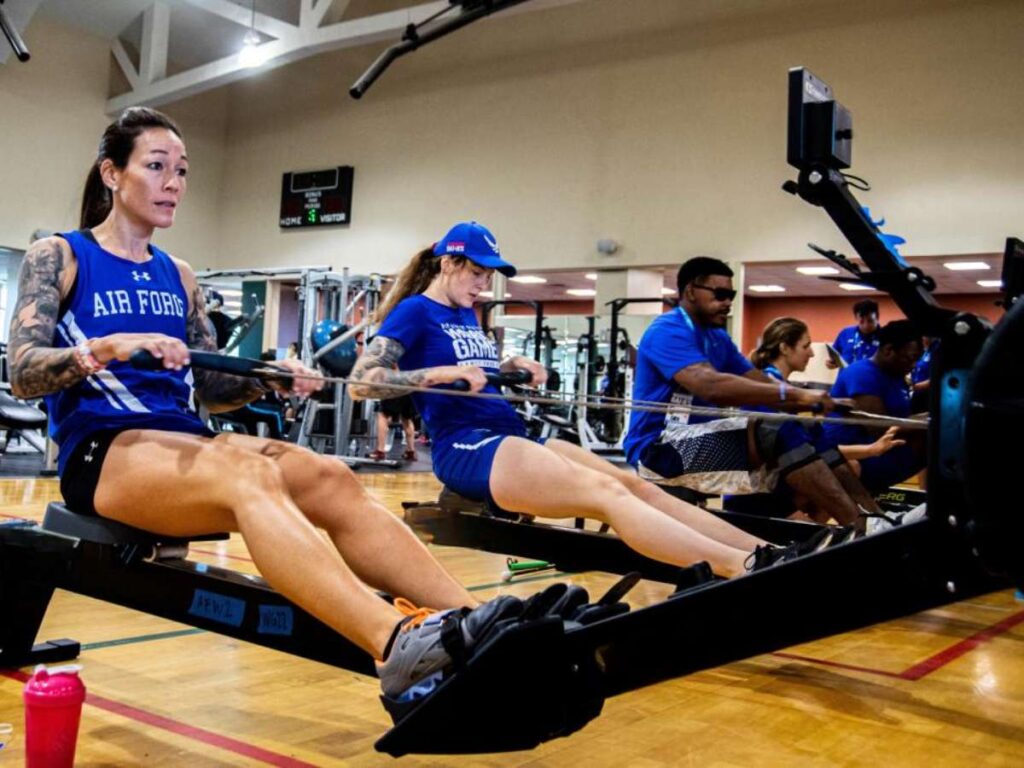
Use Trends I’ve Noticed
Here’s what I’ve seen across commercial gyms:
- Stationary bikes usually get steady, daily use
- Members feel comfortable jumping on for 10–30 minutes
- Bikes often outlast rowers in terms of member interest
- Rowing machines get used less frequently, but more intensely
Sometimes, the rower becomes the “intimidating” machine in the corner. Great tool, but underused.
That’s why I always ask my clients: Who’s walking through your doors? If your members include rehab clients or older adults, consider comparing how recumbent and upright bikes stack up in comfort and ease of use.
If your members skew older, new to fitness, or recovering from injury bikes are the safe bet. If you’ve got younger, more advanced users, rowers can bring a powerful option to the floor.
The best choice? The one they’ll actually use.
2. Space and Layout Considerations for Your Gym or Showroom
A gym owner once told me, “I love rowing machines—but they don’t love my floor plan.”
He wasn’t wrong.
Space is a dealbreaker. You can love the performance of a machine, but if it doesn’t fit, it doesn’t work. That’s especially true for small to medium gyms or distributors planning a showroom.
So let’s talk space.
Which One Takes Up More Room?
Here’s a quick size breakdown:
- Rowing machine: Around 8 feet long and 2 feet wide
- Stationary bike: Roughly 4 feet long and 2 feet wide
That’s a big difference.
Rowers take almost double the floor length of a bike. And that matters if you’re fitting multiple machines in one zone.
I’ve had clients try to squeeze in two rowers where four bikes could’ve gone. It didn’t work.
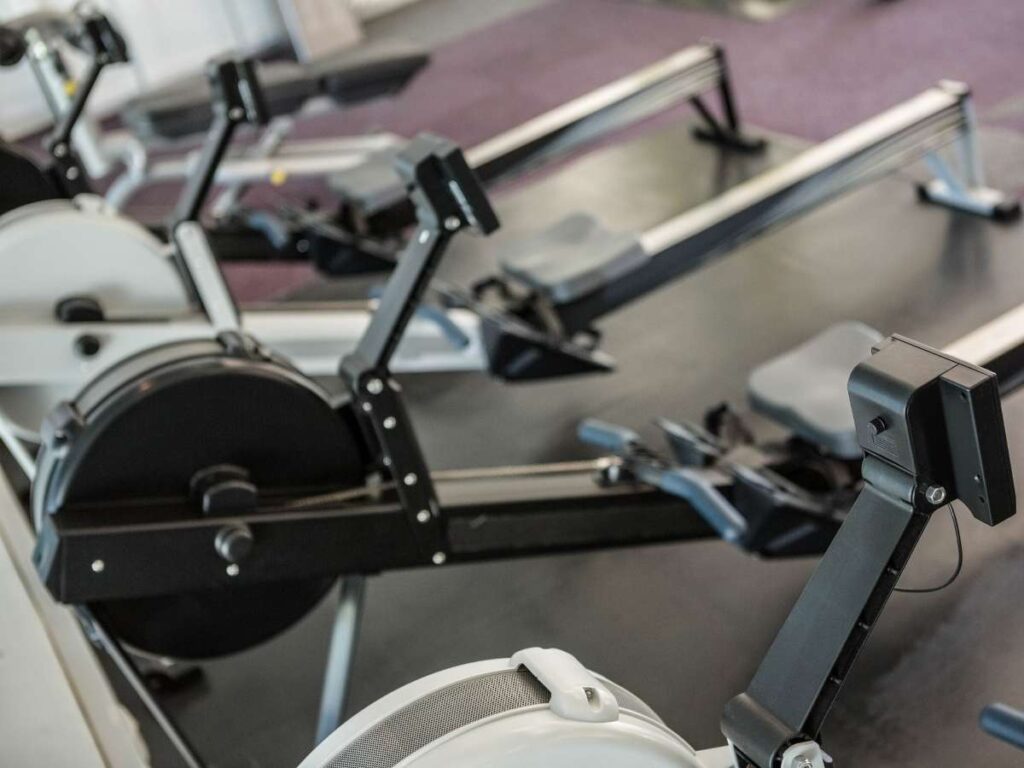
Can You Store It Easily?
If you’re limited on floor space, mobility matters.
- Many rowing machines fold up or store vertically
- Most stationary bikes are fixed. You set them, and they stay
So even though rowers are longer, you might reclaim that space when not in use. Just keep in mind folding models often cost more and aren’t as durable for heavy-use gyms.
Best Ways to Maximize Your Floor
Here’s what I suggest to my clients:
- Place bikes in rows near walls or in cardio zones
- Keep rowers in flexible areas spaces where you can store or slide them after classes
- Leave clear walkways so staff and members don’t feel cramped
- Use mirrors and corner placements to make smaller gyms feel more open
If you’re running classes or circuit training, keep mobile equipment near open zones. That way, trainers can move machines when needed without disrupting others.
What Are Members Actually Using?
This part’s key.
You could give a rower prime space on your floor. But if it just collects dust, that’s wasted real estate.
Track usage for a week or two. See what’s moving and what’s not. Because at the end of the day, the best machine isn’t just the one that fits.
It’s the one your members actually walk up to and use.
3. Maintenance, Durability, and Commercial Longevity
One of my clients once told me, “The machines looked great on delivery day. But six months later? I was spending more on repairs than I’d planned for the entire year.”
I’ve seen this happen too often.
That’s why durability and maintenance matter just as much as cost—maybe more. A cheaper machine that breaks often will end up costing you more in the long run.
What Breaks First?
Let’s start with what usually needs the most attention.
Rowing Machines:
- The chain needs regular oiling
- The seat track collects dust, hair, and sweat cleans it often
- Foot straps worn down for heavy use
Stationary Bikes:
- Belt or chain tension can loosen over time
- Pedals get loose or crack (especially under heavy users)
- Adjustment knobs sometimes wear out
Both types need regular cleaning and inspection. But bikes tend to have fewer moving parts exposed, so maintenance is usually simpler.
What Holds Up Better Over Time?
If your gym has high foot traffic like 100+ users a day you’ll want something built to take a beating.
In my experience:
- Stationary bikes generally last longer with less drama
- Rowing machines, while tough, need more upkeep to stay smooth
Gyms that don’t clean rower tracks weekly often end up replacing them too soon.
That’s why I always ask clients: “Do you have the staff to keep this machine in shape?”
If the answer is no, go with the option that needs less attention, usually the bike.
Warranty and Service Support
Here’s what most commercial warranties look like:
- Stationary Bike
- Frame: 5–10 years
- Parts: 1–3 years
- Labor: 1 year
- Rowing Machine
- Frame: 5 years
- Parts: 1–2 years
- Labor: 6 months to 1 year
Look for brands that have:
- Local service teams
- Fast parts shipping
- Easy-to-reach customer support
I’ve worked with some great companies—and a few that vanished after the sale. So before you buy, call the service number. See if someone picks up.
Because it’s not just about how the machine works on Day 1. It’s about how easy it is to fix on Day 180.
4. Cost Comparison: Upfront Investment and Long-Term Value
I remember helping a small gym owner choose between two cardio options.
One was a flashy rowing machine. The other, a solid commercial bike. He said, “The rower looks cooler, but will people even use it?”
That question led to a deeper one: Which machine actually pays off in the long run?
Let’s break it down.
Initial Price: What You’ll Pay Upfront
Here’s the average cost I’ve seen for commercial-grade machines:
- Rowing Machine: $800–$1,800
- Stationary Bike: $700–$2,500
Rowers are usually cheaper up front. But high-end bikes can get expensive—especially those with screens or magnetic resistance.
At YR Fitness, we work closely with gyms to offer commercial-grade cardio machines that strike a balance between price and performance. Whether you’re outfitting a large chain or a local studio, we help you get the best value without overpaying for branding.
So if you’re working with a tight budget, rowing machines might seem like the better deal—especially when compared to higher-ticket items like power cages or squat racks used for strength training. But there’s more to consider.
Operational Costs
Here’s what you’ll want to factor in over time:
- Stationary bikes use little to no power
- Some rowing machines use fan resistance (no power), while others use screens that need electricity
- Parts replacement tends to be more frequent with rowing machines (seat rollers, foot straps)
- Bikes usually need occasional belt or pedal replacements
Bottom line? Bikes tend to have lower ongoing costs.
Lifespan in a Commercial Gym
From what I’ve seen in real gyms:
- Rowing Machine: Lasts 3–6 years with regular upkeep
- Stationary Bike: Often lasts 5–8 years, sometimes longer if well maintained
If your gym gets heavy use, that extra lifespan can make a big difference.
Return on Investment (ROI)
Let’s compare two common scenarios:
- Budget Gym: If you’re trying to fill your floor without overspending, a rowing machine might be the quick fix. But if it doesn’t get used? It becomes dead weight.
- Premium Fitness Center: Members expect comfort, performance, and tech. A high-end bike with a screen might draw more consistent use and give better long-term value.
Here’s the truth I’ve learned: The machine that brings members back again and again is the one that pays off.
Sometimes that’s the cheaper option. Sometimes, it’s the one with better support and longer lifespan. So don’t just look at the price tag. Look at how it fits your gym and your people.
5. Member Engagement and Retention Impact
One of my long-time clients once said, “I don’t just want machines that work I want machines that keep people coming back.”
And that stuck with me.
Because it’s true. A treadmill can be solid. A bike can be reliable. But if no one enjoys using them? You lose engagement. And that leads to cancellations.
Let’s talk about how rowers and bikes impact your members’ habits and your bottom line.
Which One Keeps Members Coming Back?
The answer depends on what your members enjoy, and what makes them feel like they’re making progress.
Here’s what I’ve seen:
- Stationary bikes are easy to use. Members don’t have to think. They hop on, pedal, watch a show, or join a class.
- Rowing machines feel more intense. They give a full-body workout, and members who like challenges tend to love them.
But for beginners? Rowers can feel awkward or hard to get right. That’s where engagement drops off.
Perceived effort vs. enjoyment matters more than we think.
If a machine feels punished, people avoid it. If it feels doable and effective they keep coming back.
Group Training: A Hidden Advantage
This is where both machines shine but in different ways.
- Rowing machines work great in small-group HIIT classes. I’ve seen gyms build 30-minute circuits around rowers. It works well for younger, performance-driven members.
- Stationary bikes dominate in group settings. Spin classes, low-impact cardio sessions, and endurance rides bikes have built-in community appeal.
When members work out together, retention goes up. And group classes are a big reason why.
Offer Both, If You Can
Here’s something I tell gym owners all the time:
“You don’t have to choose just one. If you’ve got the space, offer both. Let your members pick their favorite.”
Giving people variety keeps things fresh. And it helps you serve different fitness levels from the rehab client to the athlete.
So if you want better engagement? Better retention?
Think beyond the machine. Think about how people use it and how it fits into the larger gym experience.
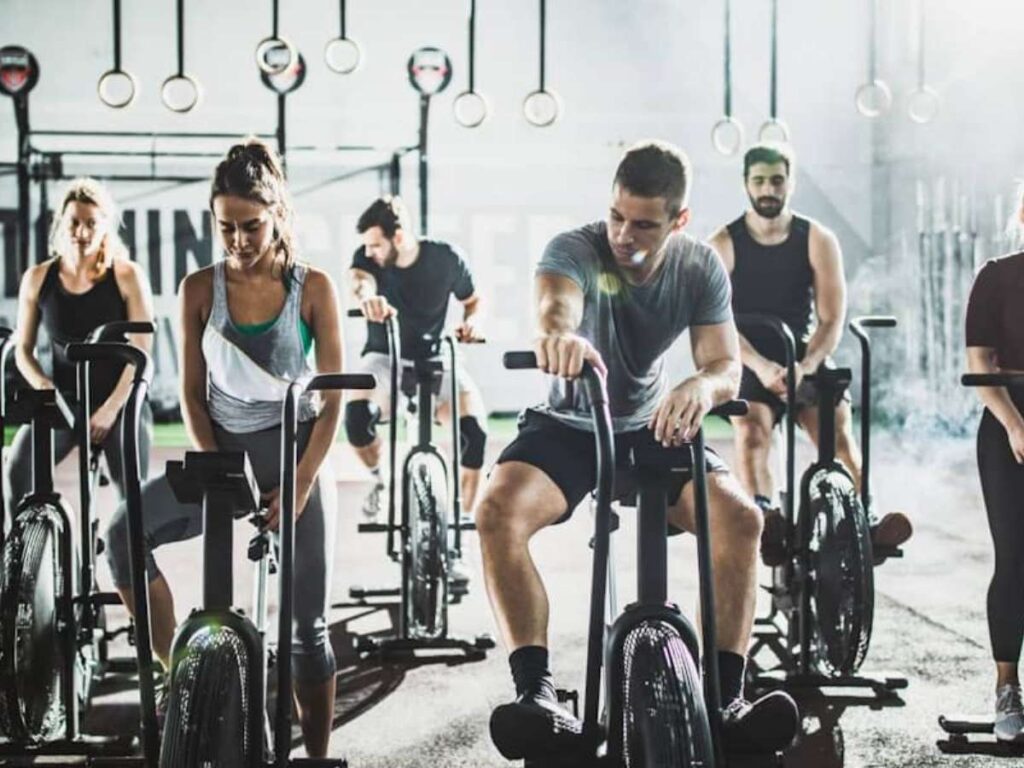
6. Market Demand Insights for Distributors
Last year, I spoke with a distributor who said, “We used to sell twice as many treadmills. Now? Clients are asking for bikes especially ones with screens.”
That shift didn’t surprise me.
The cardio equipment market keeps moving. And if you’re a distributor, you’ve got to stay ahead not just on pricing, but on what gyms are really asking for.
Let’s look at where things stand now, and what you should stock moving forward.
What’s Hot in 2025?
Right now, stationary bikes are leading the demand curve.
Why?
- They’re easier to use
- They fit all ages
- They work well in both home and commercial settings
- And spin classes are still growing
Rowing machines still sell well, but mostly in:
- HIIT-focused gyms
- Boutique fitness studios
- Training facilities
If your customers are general gyms or budget fitness centers, bikes tend to move faster.
Resale and Leasing: Which Holds Value?
I’ve worked with partners who lease to smaller gyms and rehab centers.
Here’s what they’ve told me:
- Stationary bikes hold value longer
- Fewer moving parts
- Less wear-and-tear complaints
- Easier to refurbish
- Rowers, while durable, lose value faster when scuffed or worn—especially if they don’t fold
If resale or leasing is part of your business model, bikes are usually the safer bet.
Brands Worth Carrying
From what I’ve seen and sold, these brands get solid reviews, good support, and strong customer return:
For Stationary Bikes:
- Life Fitness
- Schwinn
- Spirit Fitness
- Keiser
For Rowing Machines:
- Concept2
- WaterRower
- Matrix
- Technogym
When choosing models to stock, I always recommend this:
Stick with brands that offer fast service, clear warranties, and solid parts availability.
Your clients aren’t just buying machines. They’re buying support. And if you back the right brands, they’ll come back to you too.
In a shifting market, loyalty is everything.
7. Safety, Injury Risks, and User Guidance
A gym owner once called me after a member complained about back pain from the rowing machine.
“She said it felt like her spine was twisting,” he told me. “But I watched her form and yeah, it wasn’t good.”
That story isn’t rare. In fact, it’s common.
Both rowing machines and stationary bikes are safe when used correctly. But used wrong? They can lead to real problems.
Let’s look at where things go wrong and how to fix it.
Common Mistakes I See
On Rowing Machines:
- Members yank with their arms instead of pushing with their legs
- They round their backs instead of staying upright
- Fast strokes with bad form lead to lower back strain
On Stationary Bikes:
- Seat too low = knee pain
- Seat too high = hip strain
- Poor posture = neck or back tension
These issues don’t always show up on Day 1. But over time, they turn into discomfort, injuries—or worse, dropouts.
How to Keep Members Safe
You don’t need full-time coaching to prevent injuries. But you do need guidance.
Here’s what I suggest:
- Put up simple, visual signage near each machine
- Use diagrams showing correct form and posture
- Keep language easy to read and large enough to see from the machine
- Offer quick induction sessions for new members
- 5 minutes with a trainer to show how to set seat height
- A short demo on the rower’s push-pull movement
- Focus on alignment and breathing
- Check in during busy hours
- Your staff doesn’t have to hover, but a quick “Hey, want a tip?” can go a long way
I’ve found that small bits of support lead to better results and fewer injuries. And here’s the real benefit: when members feel guided, they feel valued.
That leads to better form, fewer complaints, and stronger loyalty.
So if you’re investing in bikes or rowers, don’t stop at the sale. Help your members use them well. That’s where the real value shows up.
8. Final Decision: Which Machine Is Better for Your Business?
A gym owner once asked me, “If you had to pick just one—bike or rower—which would you choose?”
And I gave the honest answer: “It depends on who you’re serving, how much space you’ve got, and what you want the machine to do for your business.”
There’s no one-size-fits-all here. But there is a best fit for your setup.
Let’s break it down.
Quick Comparison: Side-by-Side
Here’s a simple snapshot of how the two stack up:
- Cost
- Rowing Machine: Lower upfront
- Stationary Bike: Wider price range
- Space
- Rower: Longer footprint, some fold
- Bike: Smaller, fixed position
- Maintenance
- Rower: More upkeep (chains, tracks)
- Bike: Fewer issues over time
- User Appeal
- Rower: Advanced, athletic users
- Bike: Beginners, seniors, rehab clients
- ROI
- Rower: Good for HIIT and classes
- Bike: Higher daily usage and resale value
Recommendations Based on Gym Type
Small Boutique Gyms
- Limited space? Start with a bike.
- Easier to maintain. More user-friendly for all levels.
Large Commercial Gyms
- You’ll need both.
- Bikes for daily traffic. Rowers for variety and performance training.
Distributors
- If you’re stocking in bulk, bikes are safer.
- Higher turnover. Easier resale. Lower maintenance complaints.
One Last Thought
Don’t rush the decision.
Walk your gym floor. Think about your members. What do they need? What do they actually use?
If you’re a distributor, look at demand trends and choose brands with strong support—like YR Fitness. We build cardio equipment that balances value, reliability, and real-world performance for gyms across the globe.
The right machine should fit your space, serve your people, and hold up under pressure.
Pick the one that fits your business, not just the one that looks good on paper. Because in the end, it’s not about features it’s about fit.
Conclusion
That gym owner who picked five treadmills?
He ended up swapping two bikes and his members came back.
You’ve now got everything you need:
- What each machine offers
- How they perform
- What your members really want
- And which one makes more sense for your space and budget
So here’s the question what’s the next move for your gym or business?
You don’t have to guess. You just have to choose what fits.
Contact us today if you want help deciding.
Related articles:
